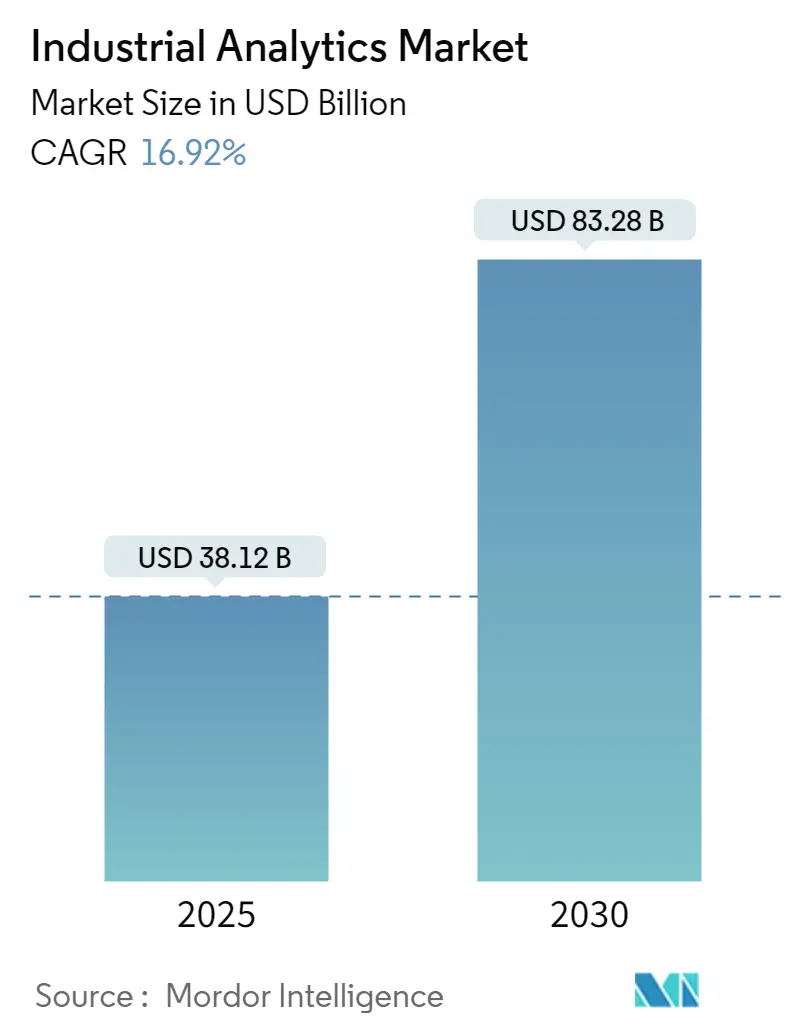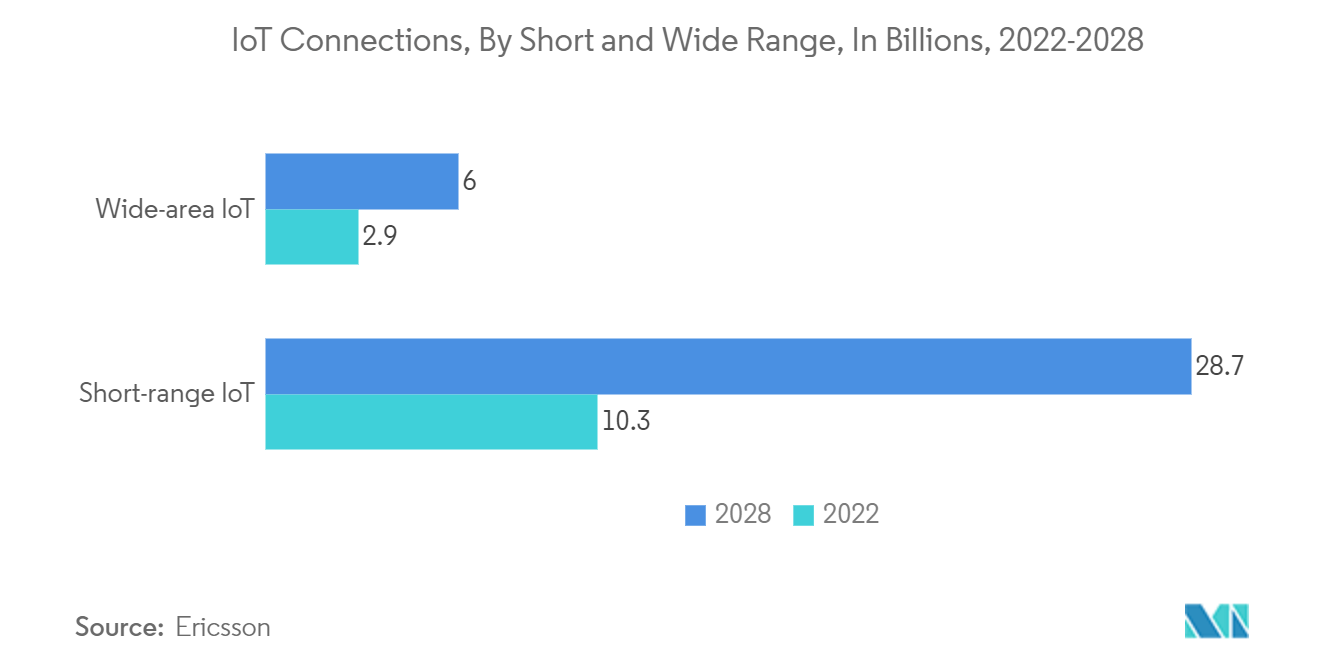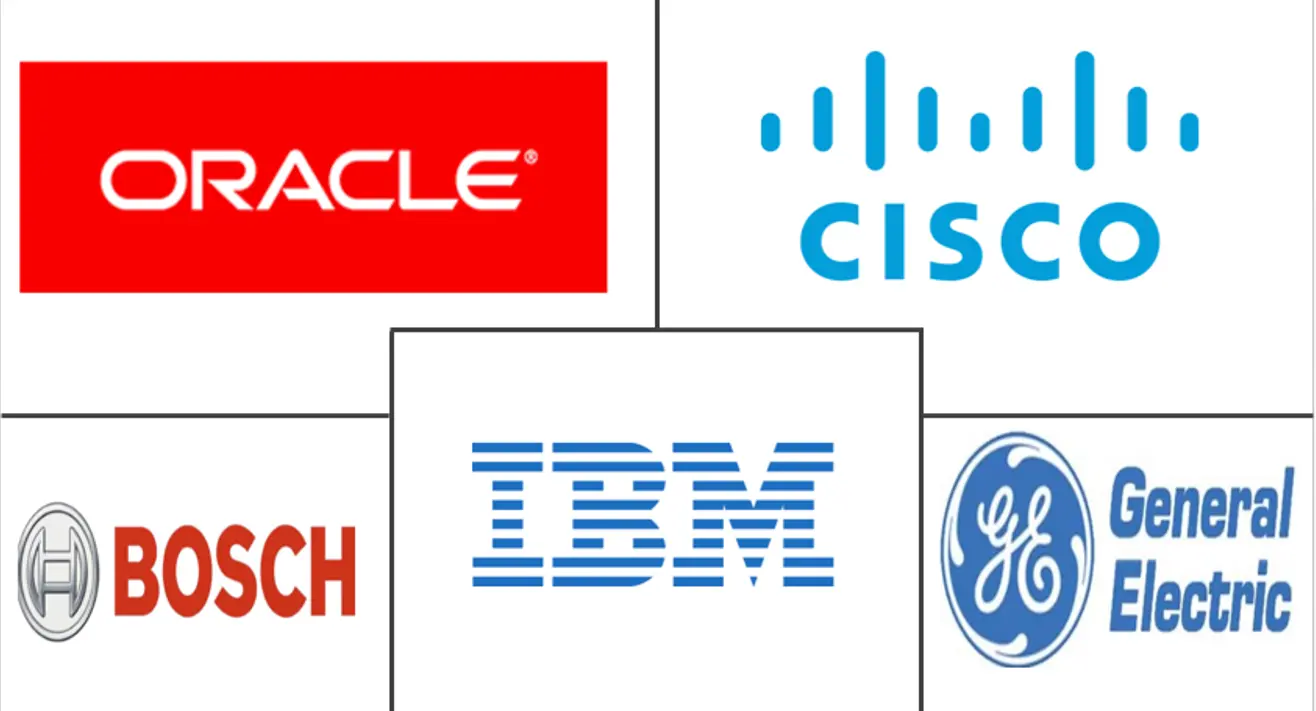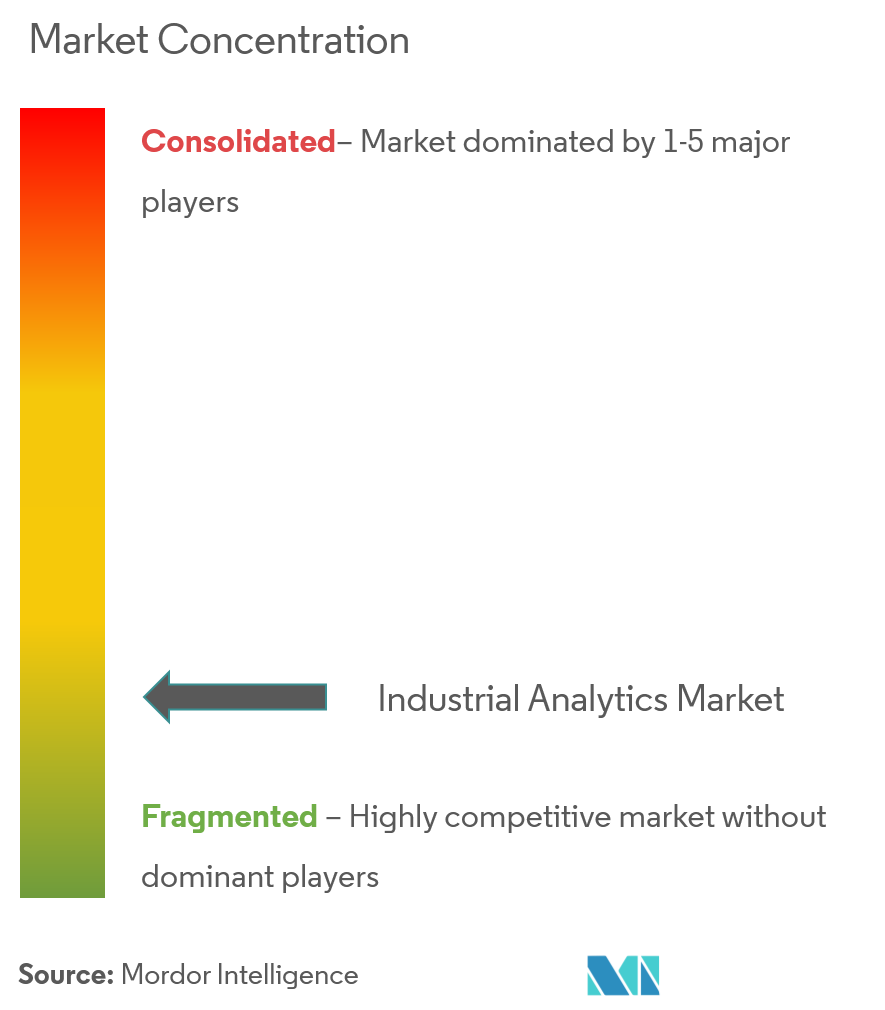
Industrial Analytics Market Analysis
The Industrial Analytics Market size is estimated at USD 38.12 billion in 2025, and is expected to reach USD 83.28 billion by 2030, at a CAGR of 16.92% during the forecast period (2025-2030).
The rising Industry 4.0 will drive the market in the forecast period. An increasing number of IoT and IIoT installations are the primary enablers of industrial analytics in the global market. The growing data available from multiple sources across the production line, such as sensors, machine vision systems, PLCs, etc., are moving industries from data metrics models to data analytics models.
- Industrial analytics includes collecting, analyzing, and using data generated in industrial operations. It covers a wide range of data captured from devices and sources, whether an asset or a production process. Anything with the sensor creates data, and industrial analytics examines all this data.
- Industrial analytics differs from Big Data analytics systems in that they are designed to meet the exacting standards of the industry in which they work. It includes processing vast quantities of time series data from numerous sources and turning it into actionable insights. Industrial analytics is relevant to any company that manufactures and sells physical products.
- The typical and traditional approach to industrial analytics involves data scientists building an analytics model. Data scientists must understand the use case scenario and then gather, transform, optimize, and load the data in the developed data model, which needs to be validated, optimized, and trained. The completed data model delivers answers to the initial questions.
- However, this approach leaves organizations dependent on their data scientists and results in a solution that subject matter experts (SMEs) (engineers and operators) might need to fully understand. Moreover, the market witnessed a growing trend toward self-service applications in the past few years. This next generation of software uses advanced search algorithms, machine learning (ML), and pattern recognition technologies to make querying industrial data as easy as using Google.
- An industrial analytics solution focuses on self-service, resulting in benefits to day-to-day plant operation. It includes enhanced root cause analysis, accurate performance prediction, automated monitoring, and knowledge retention. By sharing analytics insights with users, they can take immediate action when a trend appears and directly contribute to improving overall plant performance at all production levels.
- The COVID-19 outbreak forced companies worldwide to adjust their strategies to survive in the 'new normal.' Customers have changed their priorities, too. Many are shopping online or have found that the stores they frequented in person not so long ago only provide deliveries. Businesses witnessed surges in demand for some products, while entire industries virtually ceased operations due to COVID-19 shutdowns impacting the market adversely.
Industrial Analytics Market Trends
Manufacturing Sector to Dominate the Market Over the Forecast Period
- Industry 4.0 is transforming the manufacturing industry by leaps and bounds by enabling them to make a global shift toward the futuristic manufacturing sector. With the advent of industry 4.0 in the manufacturing industry, various plants adopt digital technologies, such as IIoT, AI, ML, Robotics, and many more, to enhance, automate, and modernize the whole process.
- Integrating different technologies is becoming prevalent, as it provides exceptional benefits. Leveraging the technologies, as mentioned earlier, into a new way of doing business is a crucial factor in Industry 4.0 for companies to gain a competitive edge and be more profitable and scalable.
- Technologies like Industrial IoT are expected to connect millions of things to ensure that automation can be achieved across the entire value chain. Implementing analytics in the manufacturing industry is expected to boost customization and automation by collecting the vast amount of data generated by these technologies in real time, providing actionable insights to the manufacturers, reducing machine downtime, and enhancing productivity.
- The industrial analytics application is expected to gradually improve production processes' productivity and efficiencies throughout the supply chain. For instance, the manufacturing processes would be capable of administering themselves, using intelligent machines and devices that can take corrective action, to avoid machine breakdowns. Individual parts would be automatically replenished based on real-time data.
- Data-driven companies in the manufacturing sector are already using IoT-generated data by feeding them into their existing analytical pipeline and improving operational management and efficiencies by reducing variable costs.
- Innovative opportunities are significantly increased by the technology availability related to the Internet of Things (IoT) and advanced analytics. Manufacturers are accustomed to utilizing IoT technology in their factories, where networked sensors allow for better planning and predictive maintenance. Many manufacturers currently invest in 5G-based mobile private networks for their on-premises edge cloud. Significant benefits of this strategy include speed, low latency, reliability, capacity, and strong security. A quarter of the more than 150 4G/5G-based private networks that have been publicly reported employ 5G. Manufacturers use about 40% of all of these. IoT and 5G-based industrial applications may greatly benefit from these 5G-based clouds. These factors are analyzed to boost the market growth rate during the forecast period.

North America to Account for Significant Market Share
- The advanced technologies used, such as cloud computing, AI, big data and analytics, mobility/social media, cybersecurity, and IoT, have led to innovation and transformation, thereby stimulating growth in the business ecosystem of North America. These technologies have transformed the legacy approach to business into a modern approach. Also, the region is becoming a new hotspot in the digital transformation market due to rising investments in digitalization across potential economies. Such trends are expected to boost the adoption of industrial analytics across the industries in the region.
- The United States, for instance, is expected to dominate the Industry 4.0 market globally, as the companies in the country are rapidly adopting the concept of smart manufacturing. Industry 4.0 technologies provide improved operational efficiency, enhanced productivity, optimization of costs, and reduction in downtime. Most of the factories in the country are already equipped with modern machines and smart factory technology, which uses industrial analytics. It enables them to gather actionable insights by deploying technologies across their industries.
- Further, the growth in the advanced communication technologies deployment across industries is expected to create significant opportunities for adopting industrial analytics in the region. According to GSMA, in the previous year, 5G connections were forecast to account for 14% of all mobile connections in North America. By 2025, it is expected to reach 46% of the total connectivity. Since fast and secure 5G connectivity is expected to enable agile operations and flexible production, the technology is expected to facilitate automated warehouses, automated assembly, connected logistics, packing and product handling, and autonomous carts.
- For example, according to GSMA, IoT professional services revenue and IoT connectivity revenue in North America amounted to USD 25 billion and USD 8 billion in 2018 and are forecasted to reach USD 101 billion and 16 billion in 2025. SMEs are becoming increasingly flexible in incorporating new technologies with their existing systems, whereas large manufacturers have heavy budgets for digitization, thus giving momentum to industrial analytics in the region.

Industrial Analytics Industry Overview
The major players include Intel, Cisco Systems, IBM, General Electric, Amazon.com, Oracle Corporation, Hewlett-Packard, Microsoft Corporation, and Genpact, amongst others. The market is fragmented since there is high competition among major players due to the adoption of industry 4.0 and the companies spending heavily on R&D for better operational activities. Therefore, the market concentration will be low.
- August 2022-Industrial Analytics, a firm based in Berlin, was acquired by Infineon Technologies AG. Infineon is enhancing its artificial intelligence software and services business to perform predictive analysis on machinery and industrial equipment. Infineon is acquiring all outstanding shares of the business. Based on the collection and evaluation of vibrations, Industrial Analytics creates artificial intelligence systems that, for instance, monitor plants for the early detection of significant developments. Industrial Analytics' AI solutions analyze data for predictive maintenance and make actionable suggestions.
Industrial Analytics Market Leaders
-
Cisco Systems
-
IBM Corporation
-
General Electric Company
-
Oracle Corporation
-
Robert Bosch GmbH
- *Disclaimer: Major Players sorted in no particular order
Industrial Analytics Market News
- November 2022-Fractal, a developer of artificial intelligence and advanced analytics solutions to Fortune 500 enterprises, announced the introduction of Asper.ai today. Asper.ai is a purpose-built linked AI solution for consumer goods, manufacturing, and retail, building on the company's existing AI capabilities.
- January 2022: Dunnhumby, the prominent player in Customer Data Science, announced a new strategic collaboration with SAP, the industry leader in business application software, to assist retailers in integrating sophisticated customer insights into their marketing and merchandising operations. The collaboration will enable businesses to make quicker, client-driven choices and provide a more individualized in-store and online shopping experience. As they prepare for the future of retail, retailers will be better able to transform customer data into unambiguous actions to streamline and improve routine business procedures.
Industrial Analytics Industry Segmentation
Industrial analytics is the tool that turns machine data into actionable insights, thereby promoting efficient industry operations and business processes. Industry analytics tools use traditional data capture and statistical modeling methods and pair them with advanced analytics algorithms.
The Industrial Analytics Market is segmented by deployment (on-premise, cloud), component (software, services), type (predictive analytics, prescriptive analytics, descriptive analytics), end user (construction, manufacturing, mining, transportation, and other end-user industry), and geography (North America, Europe, Asia-Pacific, Latin America, and Middle East & Africa).
The market sizes and forecasts are provided in value (USD million) for all the above segments.
| By Deployment | On-premises |
| Cloud | |
| By Component | Software |
| Services | |
| By Type | Predictive Analytics |
| Prescriptive Analytics | |
| Descriptive Analytics | |
| By End User Industry | Construction |
| Manufacturing | |
| Mining | |
| Transportation | |
| Other End User Industry | |
| By Geography | North America |
| Europe | |
| Asia Pacific | |
| Latin America | |
| Middle East and Africa |
Industrial Analytics Market Research FAQs
How big is the Industrial Analytics Market?
The Industrial Analytics Market size is expected to reach USD 38.12 billion in 2025 and grow at a CAGR of 16.92% to reach USD 83.28 billion by 2030.
What is the current Industrial Analytics Market size?
In 2025, the Industrial Analytics Market size is expected to reach USD 38.12 billion.
Who are the key players in Industrial Analytics Market?
Cisco Systems, IBM Corporation, General Electric Company, Oracle Corporation and Robert Bosch GmbH are the major companies operating in the Industrial Analytics Market.
Which is the fastest growing region in Industrial Analytics Market?
Asia Pacific is estimated to grow at the highest CAGR over the forecast period (2025-2030).
Which region has the biggest share in Industrial Analytics Market?
In 2025, the North America accounts for the largest market share in Industrial Analytics Market.
What years does this Industrial Analytics Market cover, and what was the market size in 2024?
In 2024, the Industrial Analytics Market size was estimated at USD 31.67 billion. The report covers the Industrial Analytics Market historical market size for years: 2019, 2020, 2021, 2022, 2023 and 2024. The report also forecasts the Industrial Analytics Market size for years: 2025, 2026, 2027, 2028, 2029 and 2030.
Our Best Selling Reports
Industrial Analytics Industry Report
Statistics for the 2025 Industrial Analytics market share, size and revenue growth rate, created by Mordor Intelligence™ Industry Reports. Industrial Analytics analysis includes a market forecast outlook for 2025 to 2030 and historical overview. Get a sample of this industry analysis as a free report PDF download.




